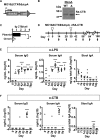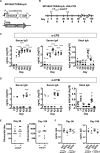Sublingual Adjuvant Delivery by a Live Attenuated Vibrio cholerae-Based Antigen Presentation Platform
- PMID: 29875145
- PMCID: PMC5990885
- DOI: 10.1128/mSphere.00245-18
Sublingual Adjuvant Delivery by a Live Attenuated Vibrio cholerae-Based Antigen Presentation Platform
Abstract
A sublingually delivered heterologous antigen presentation platform that does not depend on antigen or adjuvant purification would be of great benefit in protection against diarrheal disease. In proof-of-concept studies, we previously showed that when a fusion protein comprised of the Vibrio cholerae biofilm matrix protein RbmA and the B subunit of cholera toxin (R-CTB) is expressed from a plasmid within V. cholerae, R-CTB is sequestered in the biofilm matrix, leading to decoration of the cell surface. Sublingual delivery of live attenuated R-CTB-decorated cells results in a mucosal immune response to CTB. To improve the immune response to diarrheal antigens presented by this platform, we have engineered our live attenuated vaccine to express the mucosal adjuvant mmCT (i.e., multiply mutated CT). Here we report that delivery of this adjuvant via sublingual administration of our vaccine enhances the mucosal immune response to V. cholerae LPS and elicits a systemic and mucosal immune response to CTB. However, provision of R-CTB with mmCT selectively blunts the mucosal immune response to CTB. We propose that mmCT delivered by this live attenuated Vibrio cholerae vaccine platform may serve as a mucosal adjuvant for heterologous antigens, provided they are not too similar to mmCT.IMPORTANCE Diarrheal disease is the most common infectious disease of children in the developing world. Our goal is to develop a diarrheal antigen presentation platform based on whole Vibrio cholerae cells that does not depend on protein purification. We have previously shown the feasibility of genetically fusing antigens to the V. cholerae biofilm matrix protein RbmA for presentation on the cell surface. A mucosal adjuvant could improve immunogenicity of such a vaccine at the mucosal surface. Here we engineer a live attenuated V. cholerae vaccine to constitutively synthesize mmCT, a nontoxic form of cholera toxin. When this vaccine is delivered sublingually, in vivo-synthesized mmCT acts as both an adjuvant and antigen. This could greatly increase the magnitude and duration of the immune response elicited by codelivered heterologous antigens.
Keywords: Vibrio cholerae; cholera toxin adjuvants; live vector vaccines; mmCT; vaccine; vaccine platform.
Copyright © 2018 Liao et al.
Figures




Similar articles
-
A Self-Assembling Whole-Cell Vaccine Antigen Presentation Platform.J Bacteriol. 2018 Jul 10;200(15):e00752-17. doi: 10.1128/JB.00752-17. Print 2018 Aug 1. J Bacteriol. 2018. PMID: 29483163 Free PMC article.
-
Cholera toxin-B (ctxB) antigen expressing Salmonella Typhimurium polyvalent vaccine exerts protective immune response against Vibrio cholerae infection.Vaccine. 2015 Apr 8;33(15):1880-9. doi: 10.1016/j.vaccine.2015.02.014. Epub 2015 Feb 18. Vaccine. 2015. PMID: 25701672
-
Construction and preclinical evaluation of mmCT, a novel mutant cholera toxin adjuvant that can be efficiently produced in genetically manipulated Vibrio cholerae.Vaccine. 2016 Apr 19;34(18):2121-8. doi: 10.1016/j.vaccine.2016.03.002. Epub 2016 Mar 11. Vaccine. 2016. PMID: 26973069
-
Exploiting cholera vaccines as a versatile antigen delivery platform.Biotechnol Lett. 2008 Apr;30(4):571-9. doi: 10.1007/s10529-007-9594-0. Epub 2007 Nov 16. Biotechnol Lett. 2008. PMID: 18008168 Free PMC article. Review.
-
Biosafety aspects of the recombinant live oral Vibrio cholerae vaccine strain CVD 103-HgR.Vaccine. 2004 Jun 23;22(19):2457-69. doi: 10.1016/j.vaccine.2003.12.033. Vaccine. 2004. PMID: 15193410 Review.
References
-
- Kotloff KL, Platts-Mills JA, Nasrin D, Roose A, Blackwelder WC, Levine MM. 2017. Global burden of diarrheal diseases among children in developing countries: incidence, etiology, and insights from new molecular diagnostic techniques. Vaccine 35:6783–6789. doi:10.1016/j.vaccine.2017.07.036. - DOI - PubMed
Publication types
MeSH terms
Substances
Grants and funding
LinkOut - more resources
Full Text Sources
Other Literature Sources
Medical

